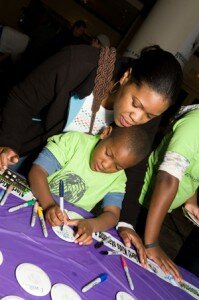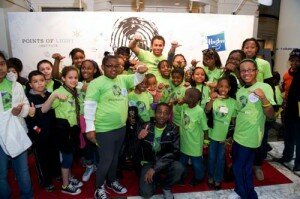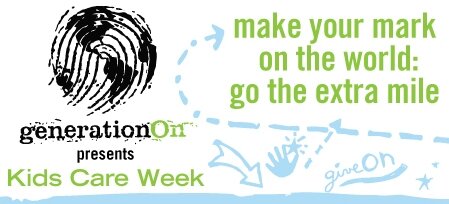 Today is a BIG day for youth service! “Why?” you ask. July 2nd is the beginning of generationOn’s summer youth service campaign, Community Action Heroes. In partnership with Hasbro, generationOn wants parents to teach their kids or teens the importance of serving their communities.
Today is a BIG day for youth service! “Why?” you ask. July 2nd is the beginning of generationOn’s summer youth service campaign, Community Action Heroes. In partnership with Hasbro, generationOn wants parents to teach their kids or teens the importance of serving their communities.
Summer is the perfect time to get kids involved in volunteerism with all the extra time they have on their hands! GenerationOn will rally thousands of youth volunteers to become active heroes within their community.
How does it work? Interested parents and youth can access the Community Action Hero app lication through the generationOn website. Kids can choose a challenge team and project ideas. Once a pledge is made, kids can also challenge their friends to be heroes through the use of social media. Once the challenge is met, kids can share their projects through video, essays, or pictures to inspire other youth. All participants will receive a certificate of completion after the project as well!
lication through the generationOn website. Kids can choose a challenge team and project ideas. Once a pledge is made, kids can also challenge their friends to be heroes through the use of social media. Once the challenge is met, kids can share their projects through video, essays, or pictures to inspire other youth. All participants will receive a certificate of completion after the project as well!
What issues can your kid pledge to volunteer for?
- Animals: Five to seven million animals are rescued by shelters annually. Your child can help animals in the community by donating cat or dog food, bathing and playing with shelter animals, cleaning a dog park, raising money for guide dog training, creating emergency preparedness packs for pets, raising money for animal shelters, etc.
- Literacy: Although summer is a great time to catch up on a new book, many kids do not have access to reading materials in their community. Kids can make a big difference for their neighbors by writing letters to policy makers asking to make education a priority, reading to other children, holding a book drive, organizing a book fair benefit, etc.
- Health: Summer is a great time to be active outside, but unfortunately not all kids are healthy enough to play outside. Your child or teen can be a hero for sick children by making a lemonade stand, making books to make a smile, bingo at a senior home, anti-bullying posters, toy drives, etc.
- Environment: No matter your age or size, we all have the power to improve our environment. Your child or teen can learn the value of helping the environment by getting his or her household to use eco-friendly cleaner, cleaning up a park or nature walk, hosting a green thumb party, cleaning up a lake or river, starting a recycling program, etc.
-
Homelessness: 770,000 homeless children are currently enrolled in United States public schools; the summer time is even harder because they do not have the safety of a
 school. Your child or teen can get involved in solving this important problem by making a work of art for a shelter, making a pillow buddy, hosting a princess party to collect fairytale books, making health kits, collecting school supplies boxes, advocating for the homeless, etc.
school. Your child or teen can get involved in solving this important problem by making a work of art for a shelter, making a pillow buddy, hosting a princess party to collect fairytale books, making health kits, collecting school supplies boxes, advocating for the homeless, etc.
- Hunger: Although summer is a special time for certain seasonal meal favorites, many kids do not receive their proper nutrients because they do not get school lunches in the summer. Your child or teen can be a hero for hungry children by participating in meals on wheels, making lunches, sharing extra food from their garden, hosting a fundraiser event to tackle hunger, etc.
- Military: Our military men and women volunteer their lives daily to better our country, Your child or teen can show his or her gratitude to military servicemen and veterans by making care packages, sending letters, sending them fun items to bring a smile, hosting a veterans’ dinner, interviewing and sharing a veteran’s story with the Library or Congress, etc.
- Emergency prep: Summer is a time to relax, but is also a time for many heat related disasters and emergencies. Be a hero in your community and get others prepared by providing hurricane victims with essential items, collecting smoke detector batteries, making and delivering first aid kits, raise awareness about summer emergencies, providing homeless shelters with evacuation plans, etc.
 The world needs more action heroes, are you up to the challenge? We hope that your children will make the pledge to accept one of these eight hero challenges to better his or her community!
The world needs more action heroes, are you up to the challenge? We hope that your children will make the pledge to accept one of these eight hero challenges to better his or her community!
Check out generationOn, the youth volunteer enterprise of Point of Light, to learn more about the Community Action Hero Challenge.


 Family volunteering enables populations whose volunteering has been restrained by family care-giving obligations (either responsibilities to children or seniors) to become involved. As a “two for one” activity, family volunteering greatly increases the ability of time-depleted working families to engage in service. It is a true “minimum time, maximum benefit” system.
Family volunteering enables populations whose volunteering has been restrained by family care-giving obligations (either responsibilities to children or seniors) to become involved. As a “two for one” activity, family volunteering greatly increases the ability of time-depleted working families to engage in service. It is a true “minimum time, maximum benefit” system.


 This week NBC is hosting
This week NBC is hosting 



 Also, did you know that October 23rd is Make A Difference Day,the largest, annual day of service?
Also, did you know that October 23rd is Make A Difference Day,the largest, annual day of service?



 1. Determine What You Can Contribute
1. Determine What You Can Contribute

 8. Evaluate Outcomes and Measure Success
8. Evaluate Outcomes and Measure Success Benefits for Students
Benefits for Students Benefits for Volunteers
Benefits for Volunteers
